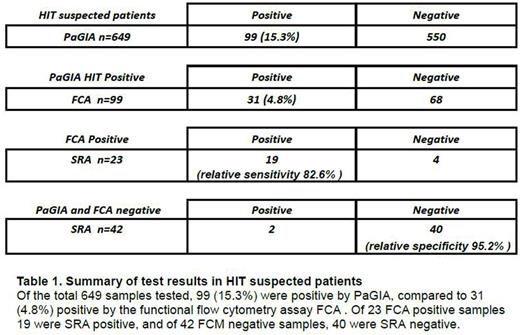Abstract
Background: Reliable diagnosis of HIT is mandatory for patient management. Commonly used antibody-detecting immunoassays carry certain limitations compared to functional assays which determine antibody-mediated platelet activation. However, current functional assays are limited by feasibility. The functional test for detecting platelet-activating antibodies is the [14C] serotonin-release (14C-SRA), considered the gold standard assay, (Sheridan D et al, Blood1986;67:27), is not commonly performed as it includes the use of a radiolabeled C14 and requires expertise to obtain reliable.
Aims: We aimed to overcome these limitations by developing a simple functional flow cytometric assay (FCA) and assess its sensitivity and specificity as compared to a widely used immunoassay and the radioactive serotonin-release assay (SRA) in correlation with clinical presentation of HIT.
Methods: Samples from patients clinically suspected for HIT were routinely tested by the PF4/H-PaGIA immunoassay (DiaMed, Switzerland), followed by the functional FCA which determines the capacity of the patient's serum to induce platelet activation in the presence of heparin, and the results were compared to those of the SRA. The assays results were correlated with the HIT presentation based on the 4Ts score.
Results: Of 649 samples sent to the routine coagulation laboratory , 99 (15.3%) were positive by the H/PF4-PaGIA and 31 (4.8%) by the FCA. Out of 23 double positive samples that were further tested, 19 were positive by the radioactive SRA (82.6%, relative sensitivity). Of 32 PaGIA-positive but FCA-negative samples, 30 (93.8%) were also negative by the SRA, and 10 samples negative by both tests were all negative by the SRA. Overall, of 42 negative samples by FCA, 40 were negative by the SRA showing relative specificity of 95.2%.
Following sample dilution of 1:32 (Nellen V. et al, Haematologica 2012;97:89), the H/PF4-PaGIA-positive results decreased to 29 (4.5%), constituting a 70.6% reduction, whereas the number of FCA-positive results (4.8%) remained consistent, indicating the specificity and the high sensitivity of the assay following high dilution. Forty normal samples were all negative by both assays.The overall agreement between the FCA and the PF4/H-PaGIA immunoassay following dilution was 93.1% for positive (sensitivity) and 94.3% for negative results (specificity). Overall, the FCA showed significantly higher correlation with the clinical presentation of HIT (4Ts score) compared to the PF4/H-PaGIA (ROC-plot analysis, AUC 0.93 vs. 0.63, p<0.001). At a cut-off level of 92% sensitivity, the respective specificity of the FCA was 96%.
Conclusions: Our findings demonstrate that the easily performed functional FCA is practical for routine daily use, providing reliable results for initial diagnosis, as well as confirmation of HIT.
Kirgner:Tel Aviv Sourasky Medical Center: Consultancy. Tomer:Aaron Tomer: Patents & Royalties: Pending patent.
Author notes
Asterisk with author names denotes non-ASH members.


This feature is available to Subscribers Only
Sign In or Create an Account Close Modal